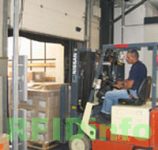
Sony (Europe) logistics supply chain deploys RFID applications
[ad_1]
Currently, Sony (Europe) is combining RFID technology and closed-circuit video surveillance technology in one of its distribution centers to improve work efficiency. The system currently used by Sony (Europe) has been used as a pilot project since last year to track single products in its warehouse in Tilburg, Netherlands, and expect to see a return on investment within one year.
The system integrator for this project is Mieloo & Alexander in Amsterdam, the Netherlands. It integrates Raflatac’s EPCglobal Class 1 Gen 2 tags, Motorola’s Symbol Technology XR480 RFID reader, Griffid’s IP video surveillance software, and Reva system’s tag collection and processing TAP, and Zebra Technology’s RM6+ RFID printer.
Sony (Europe) affixes labels to the products that leave the factory, and then records the product label numbers in each link of the distribution. The automatic video surveillance system monitors these products, displays the read tag RFID data on the video image, and establishes an MPEG4 video stream index based on the RFID information, and verifies the delivery process through the read tag data and video image. Provide proof of electronic delivery.


RFID tags are affixed to the outer packaging cartons of each product, and then the orders of each retail customer of Sony (Europe) are processed like manual orders. Separate the goods required by each customer, stack them on pallets with RFID tags, and then send them to an entrance with an RFID reader for reading. When packaging the product in film, the label must also be read. When the product passes the export, the label is read again before being loaded on the truck.
At present, just like TVs and digital cameras sent to customers in Germany, Sony (Europe) has also affixed RFID tags to consumer electronics.
Combining single product tracking technology and video image technology can reduce the chance of theft or loss of products and help Sony (Europe) and its customers maintain consistent shipping information. If a product is lost or damaged in transit, Sony (Europe) will have a visual record of these products (sorted by serial number) when they leave the warehouse.
“Sony (Europe) has the right to require operators to have intuitive data-based evidence of delivery,” said Sander Merkx, a partner of Mieloo & Alexander. “They can also profit from fast shipping and simplify operations.”
“Delivery is expensive,” said Ashley Stephenson, founder and chairman of Reva. “However, by tracking the entire process, Sony (Europe) can not only reduce losses, the system can also help verify the goods on each pallet. You can also immediately access the video system to query each product information.”
The project follows the European “Listen before Speak” protocol, requiring readers to check whether there are other reader signals before broadcasting their own signals. This is a challenge for Sony (Europe), because Europe is a dense reader-writer environment, and the frequency range of UHF RFID is narrow. The system uses more than ten RFID readers, and the probability of reading hundreds of tags at the same time is very high.
Reva’s TAP system can read the labeled boxes and place them on suitable pallets. Then, the information of the label and the location of the product will be transferred to the video server, the SAP system of Sony (Europe) and the data warehouse. “The’listen before talk’ protocol has increased the complexity of the project,” Merkx said: “If you connect multiple readers at the same time, we can clearly feel the impact on system performance. Reva’s TAP is used The system can realize simultaneous reading and writing by multiple readers.”
“TAP controls all RFID activities in this project,” Stephenson said: “We can sensibly coordinate the operations between readers as planned, so when a reader needs to read the tag, it can obtain effective reading. Signal.”
Last year, Reva and Impinj successfully demonstrated the TAP system at the London Group Distribution Center in Germany. When multiple pallets carrying dozens of products pass through 36 adjacent entrances and exits at the same time, a 98-99% reading rate was achieved.
Mieloo & Alexander was responsible for managing the process design and equipment installation of the project, and wrote the workflow code running in the TAP embedded Java environment. The workflow provides visual and auditory signals to the operator by prompting and receiving input from the operator to cooperate with the different links of collection and distribution.
Since 2004, Sony (Europe) has been conducting RFID testing in Europe together with Mieloo & Alexander, and it may expand the application of the system on other devices in the future.
[ad_2]



